Angela Ackerman's Blog: Writers Helping Writers, page 136
May 10, 2016
Six Rules that Keep Critique Partnerships Golden
A long time ago, two enthusiastic yet green writers met on an online critiquing site called The Critique Circle. They wrote stories riddled with hollow characters and cliched plots, but that didn’t stop them from becoming fast friends. Through practice, critiquing literally thousands of submissions, and spending untold hours reading and responding to forum conversations on writing, these two eventually learned a thing or three about the craft. Eventually, they even penned a few books with the word “thesaurus” in the title. Who knows, maybe you’ve seen one hanging out on a writer’s desk somewhere.
 Here’s one of the BIG lessons these two scruff-and-tumble writers learned: having a critique partner can really shorten your learning curve. The eyes, knowledge and experience of another writerly human being can give the insight and distance an author lacks. Of course, it’s all about finding the right critique partners who are a perfect fit, and understanding how to best work together. Becca and I still are going strong well over 10 years after we first met, and there’s no one I’d rather hand my work over to than her. So please help me welcome author Dee Romito who has a few “rules” to make sure our critique partner relationships stay healthy and function as they should.
Here’s one of the BIG lessons these two scruff-and-tumble writers learned: having a critique partner can really shorten your learning curve. The eyes, knowledge and experience of another writerly human being can give the insight and distance an author lacks. Of course, it’s all about finding the right critique partners who are a perfect fit, and understanding how to best work together. Becca and I still are going strong well over 10 years after we first met, and there’s no one I’d rather hand my work over to than her. So please help me welcome author Dee Romito who has a few “rules” to make sure our critique partner relationships stay healthy and function as they should.
Six Rules that Keep Critique Partnerships Golden
 Good critique partners (affectionately known as CPs) are invaluable on your publishing journey. They will be your go-to sources for questions, support along the way, and much-needed feedback.
Good critique partners (affectionately known as CPs) are invaluable on your publishing journey. They will be your go-to sources for questions, support along the way, and much-needed feedback.
I checked in with a few of my most trusted writing friends to get their thoughts on what makes a great critique partner. Here are six things you can do to be a helpful critiquer and what you might be looking for in a critique partner.
Offer suggestions. Blunt comments are not the same thing as constructive feedback.
There’s a line between being honest and being helpful. Try to explain why you think a change should be made or make a suggestion as to how to improve it.
“Something I make sure I don’t do (or at least try not to) is to simply say I don’t like something. That is never helpful information. If there is something that I think is off, I try to explain why I think that. For example, ‘This sentence felt repetitive because you gave the same information above.’” – Janet Sumner Johnson, author of THE LAST GREAT ADVENTURE OF THE PB&J SOCIETY
“I once had a reader who crossed out whole pages of my manuscript and rewrote sections and, knowing how that made me feel, I will never change anything in anyone else’s document. I won’t even add a comma or correct spelling in the ms itself- I drop a note in the ‘insert comments’ instead.” – Jen Malone, author of MG and YA novels, including THE SLEEPOVER and YOU’RE INVITED
Ask questions
If there’s something you don’t understand or you feel like something’s missing or unclear, ask about it. Writers are sometimes too close to their own work to see it.
“I really love receiving critiques where the CP has asked questions instead of making comments (example: ‘Do you think she’d be feeling this right here?’ instead of ‘I don’t like the way she’s feeling sad here- she should be mad!’)” – Jen Malone
“I like critique partners who ask a lot of questions. This always helps me think about different paths I can take a manuscript.” – Jen Maschari, author of THE REMARKABLE JOURNEY OF CHARLIE PRICE
Point out what works, as well as what doesn’t work
This might sound like a no-brainer, but you need to make a conscious effort to point out both the weaknesses and the strengths of a piece.
“My go-to critique partners aren’t afraid to tell me what I need to fix . . . even when they know I won’t be happy to hear it, but at the same time, they are nice. They point out the things they liked, too, and somehow this makes the hard stuff much, much, much easier to swallow.” – Janet
“I always try to point out things I love or that made me laugh, in addition to the things I didn’t connect with quite as much- I have one CP who highlights lines or sections she loves in green highlighter. For me, it definitely keeps my spirits up amid digesting all the things I need to address in revisions.” – Jen Malone
“Many times, writing can feel like pushing a boulder up a hill, so those hearts or ‘I love this’ comments or even a smiley face can go a long way to cheering me on as I tackle the bigger stuff.” – Jen Maschari
Know what the author is looking for. Overall, line edits, voice, consistency, something specific.
At various points in the process, writers need different kinds of critiques. Know what the goal is.
“I make sure I know what the person is looking for. Did they want a big picture critique? Did they want me to fix grammar mistakes? That can make a big difference in how I read.” – Janet
“I always make sure I get a sense of what my critique partner wants first. What big questions do they have? Do they want me to look at the larger picture or do they want a sentence level look?” – Jen Maschari
Offer to clarify, answer more questions, talk it through, brainstorm.
A CP is meant to be a sounding board and someone who can help you work through the sticking points.
“Now that I’ve worked on some co-writing projects and realized how much more quickly a plot/outline comes together with joint brainstorming sessions, I’ve recently begun asking my CPs if they would be up for helping at the earliest stages of something new.” – Jen Malone
“Sometimes I’ll send a few scenes out to get a first reaction or a sense of what’s working and what’s not early on.” – Jen Maschari
CPs will go to you for your strengths. Know what they are.
Okay, so you might not know them yet. But you will. Do you notice every punctuation mistake? Do you find inconsistencies in manuscripts? Are you a plotting wizard?
“I definitely choose my beta readers based on what type of critique I’m looking for. For example, when I send a second draft out (I never send a 1st draft, just fyi), I look for someone who is good at plotting and seeing holes and how to improve that. When I’m further in the process and need someone who is good at making smooth prose or catching detail errors, I choose someone who is good at that. I have found that they each have their strengths. And it always makes sense to play to someone’s strengths.” – Janet
“I have a CP whose strengths are my weaknesses- I tend to focus on dialogue and plot more than the interior character arc and she’s always making notes that say “But what is she feeeeeeeling here?”– I really need that push!” – Jen Malone
Final Thoughts
These ladies have definitely helped me along the way and were essential in fine-tuning my middle grade debut, THE BFF BUCKET LIST. I trust their feedback and value their opinions. Without a doubt, having critique partners has been one of the most important pieces in my path to becoming a published author.
Whether you’re just starting out and are in the midst of searching for critique partners or you’re a seasoned veteran, these simple reminders help make critique partner relationships ones that will last through many manuscripts, all the ups and downs, and hopefully, lots of publishing deals.
 Dee has a new book out, a terrific middle grade called the BFF Bucket List, and a killer blurb:
Dee has a new book out, a terrific middle grade called the BFF Bucket List, and a killer blurb:
Two best friends. Twelve challenges.
Can the BFF Bucket List save their friendship or will that get crossed off too?
(Love it? I do!)
If you like, follow this link for a closer look, or add it to your Goodreads list!
And do hook up with Dee online–visit her blog or website, hang out on Facebook or throw tweets her way on Twitter. She’s super friendly, is always around chatting it up, and would love to hear from you.
Do you have a great critique partner? What rules would you add to this list? Let us know in the comments!
The post Six Rules that Keep Critique Partnerships Golden appeared first on WRITERS HELPING WRITERS™.
May 7, 2016
Emotional Wounds Thesaurus: Growing Up in a Cult
When you’re writing a character, it’s important to know why she is the way she is. Knowing her backstory is important to achieving this end, and one of the most impactful pieces of a character’s backstory is her emotional wound. This negative experience from the past is so intense that a character will go to great lengths to avoid experiencing that kind of pain and negative emotion again. As a result, certain behaviors, beliefs, and character traits will emerge.
Characters, like real people, are unique, and will respond to wounding events differently. The vast array of possible emotional wounds combined with each character’s personality gives you many options in terms of how your character will turn out. With the right amount of exploration, you should be able to come up with a character whose past appropriately affects her present, resulting in a realistic character that will ring true with readers. Understanding what wounds a protagonist bears will also help you plot out her arc, creating a compelling journey of change that will satisfy readers.
NOTE: We realize that sometimes a wound we profile may have personal meaning, stirring up the past for some of our readers. It is not our intent to create emotional turmoil. Please know that we research each wounding topic carefully to treat it with the utmost respect.

courtesy: Todd Huffman @ Creative Commons
Definition of a cult: a small, fringe organization (often but not always defined by a religious belief system) that espouses idealogies and practices believed by others to be dangerous or extreme. For the purposes of this entry, I’ve chosen to focus on people who were once ensconced in a cult but at some point escaped or turned their back on it.
Basic Needs Often Compromised By This Wound: safety and security, self-actualization
False Beliefs That May Be Embraced As a Result of This Wound:
I am weak-minded.
I’m an easy target.
My judgment can’t be trusted.
I’ll never be able to fully free myself from the ideas that were put into my mind by the cult.
All religions are out to brainwash and control people.
You can never really trust an organization’s stated motivation.
I’m a disloyal or selfish person (for leaving the cult and one’s family and friends).
Positive Attributes That May Result: analytical, appreciative, cautious, independent, industrious, persistent, persuasive, protective
Negative Traits That May Result: antisocial, callous, controlling, cynical, defensive, evasive, inflexible, inhibited, insecure, judgmental, nervous, paranoid, possessive, rebellious, resentful, self-destructive, subservient, timid, uncooperative, volatile, weak-willed, withdrawn
Resulting Fears:
Fear of someone sucking one’s children into a cult
Fear of organized religion in general
Fear of being manipulated or controlled by anyone
Fear of being on one’s own
Fear of having to make decisions for oneself
Fear of not being able to trust one’s own mind (due to the cult’s brainwashing)
Possible Habits That May Emerge:
Avoiding or despising religious groups and organizations
Becoming controlling (in an effort to avoid being controlled again)
Becoming studious so one can make informed decisions and not be easily led by others
Avoiding organized groups (even those that aren’t religious in nature)
Difficulty making decisions for oneself
Difficulty recognizing truth from fiction
Withdrawing from others out of a fear of not being able to trust their motives
Being overly protective of one’s children
Being paranoid that one is being pursued by members of the cult
Suspecting others of dishonesty and deceit; being cynical
Worrying over the fate of loved ones still in the cult
Being overly cautious; avoiding risk
Distrusting certain aspects of the “outside world” that one was taught were bad in some way
TIP: If you need help understanding the impact of these factors, please read our introductory post on the Emotional Wound Thesaurus. For our current list of Emotional Wound Entries, go here.
For other Descriptive Thesaurus Collections, go here.
The post Emotional Wounds Thesaurus: Growing Up in a Cult appeared first on WRITERS HELPING WRITERS™.
May 3, 2016
The Setting Thesaurus Books Are Releasing Soon…Will You Help Us?
It’s a great day here at Writers Helping Writers, because Becca and I can finally write the words that we’ve been wanting to type out for over two years now: The Setting Thesaurus books are coming. In fact, they are almost here, and we couldn’t be happier. The sights, smells, tastes, sounds and textures for two hundred and twenty-five settings…and that’s just the start. Take a gander at these back jacket blurbs:
 The Rural Setting Thesaurus:
The Rural Setting Thesaurus: Making the Story World Rich, Layered, and Unforgettable
Within the pages of a book exists a world drawn from a writer’s deepest imaginings, one that has the ability to pull readers in on a visceral level. But the audience’s fascination will only last if the writer can describe this vibrant realm and its inhabitants well. The setting achieves this by offering readers a unique sensory experience. So much more than stage dressing, the setting can build mood, convey meaning through symbolism, drive the plot by creating challenges that force the hero to fight for what he wants, and trigger his emotions to reveal his most intimate feelings, fears, and desires.
USE DESCRIPTION TO PLACE READERS AT THE HEART OF EVERY SCENE
Within this volume you will find:
A list of the sights, smells, tastes, textures, and sounds for over 100 settings revolving around school, home, and nature
Possible sources of conflict for each location to help you brainstorm ways to naturally complicate matters for your characters
Advice on the many effective ways to build mood, helping you steer both the character’s and readers’ emotions in every scene
Information on how the setting directly influences the plot by acting as a tuning fork for what a character needs most and by testing his dedication to his goals
A tutorial on figurative language and how different descriptive techniques can bring settings alive for readers while conveying a symbolic message or deeper meaning
A review of the challenges that arise when writing description, as well as special considerations that apply specifically to rural and personal settings
The Rural Setting Thesaurus takes “show-don’t-tell” to new heights. It offers writers a roadmap to creating fresh setting imagery that impacts the story on multiple levels and keeps readers engaged from the first page to the last.
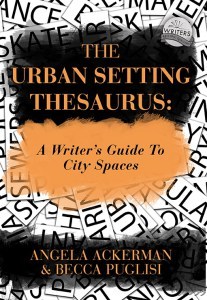 The Urban Setting Thesaurus:
The Urban Setting Thesaurus: Drawing Readers in Through Emotion-Driven Imagery and Realism
Making readers care and feel like they’re part of the story should be the number one goal of all writers. Ironically, many storytellers fail to maximize one of fiction’s most powerful elements to achieve this: the setting. Rather than being a simple backdrop against which events unfold, every location has the potential to become a conduit for conveying emotion, characterizing the cast, providing opportunities for deep point of view, and revealing significant backstory.
MAKE YOUR DESCRIPTION WORK HARDER FOR YOUR STORY
A list of the sights, smells, tastes, textures, and sounds for over 120 urban settings
Possible sources of conflict for each location to help you brainstorm ways to naturally complicate matters for your characters
Advice on how to make every piece of description count so you can maintain the right pace and keep readers engaged
Tips on utilizing the five senses to encourage readers to more fully experience each moment by triggering their own emotional memories
Information on how to use the setting to characterize a story’s cast through personalization and emotional values while using emotional triggers to steer their decisions
A review of specific challenges that arise when choosing an urban location, along with common descriptive pitfalls that should be avoided
The Urban Setting Thesaurus helps you tailor each setting to your characters while creating a realistic, textured world your readers will long to return to, even after the book closes.
The Big Question: WHEN?
June 2016! We are shooting for the second week. We would like to give you a very specific launch date, but unfortunately our longtime formatter and designer has been struggling with health issues that have caused unavoidable delays, and while everyone is doing all they can to keep things on track, Becca and I can’t provide an exact date just yet. If you would like to receive a notification when the books are available, just leave us your email.
Regardless, we do need to move forward with the planning of our launch event, and we sure could use some help. Becca and I have come up with something very fun this time around, an event we hope all our writer friends will greatly enjoy participating in.
Dear Readers, Will You Help Us During Launch Week?
To pull off this epic thesaurus celebration, we will need some supportive blogger friends who would be willing to donate some post space on their blog to the visibility cause. This post we will provide for you, can be scheduled in advance, and may go up any time during launch week that works best for you. Its purpose is to let people know about our big event so they can join in if they wish. And even if you don’t blog, it’s always nice to have people willing to share our posts online, too. 
In the past, we’ve hosted some pretty creative events, and this particular one I have had in the idea bank for years, waiting for the right time. So, if you are interested in possibly joining the Thesaurus Club to help with our SUPER SECRET LAUNCH EVENT, just fill out this FORM and I will email you about it. (This one is easy and fun, guaranteed!)
Becca and I are so pleased to bring you this set of books. The sensory detail within required a lot of travel, investigation, and time to collect. We hope these two volumes help you level up your sensory description to better pull readers into each moment, making your story and characters both compelling and memorable.
Want to sneak-a-peek at one of our entries? Just go here to see “Police Car.”
The post The Setting Thesaurus Books Are Releasing Soon…Will You Help Us? appeared first on WRITERS HELPING WRITERS™.
April 30, 2016
Emotional Wound Entry: Growing Up In Foster Care
When you’re writing a character, it’s important to know why she is the way she is. Knowing her backstory is important to achieving this end, and one of the most impactful pieces of a character’s backstory is her emotional wound. This negative experience from the past is so intense that a character will go to great lengths to avoid experiencing that kind of pain and negative emotion again. As a result, certain behaviors, beliefs, and character traits will emerge.
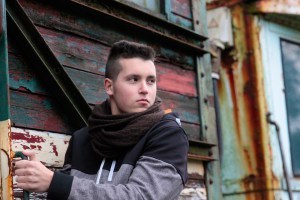 Characters, like real people, are unique, and will respond to wounding events differently. The vast array of possible emotional wounds combined with each character’s personality gives you many options in terms of how your character will turn out. With the right amount of exploration, you should be able to come up with a character whose past appropriately affects her present, resulting in a realistic character that will ring true with readers. Understanding what wounds a protagonist bears will also help you plot out her arc, creating a compelling journey of change that will satisfy readers.
Characters, like real people, are unique, and will respond to wounding events differently. The vast array of possible emotional wounds combined with each character’s personality gives you many options in terms of how your character will turn out. With the right amount of exploration, you should be able to come up with a character whose past appropriately affects her present, resulting in a realistic character that will ring true with readers. Understanding what wounds a protagonist bears will also help you plot out her arc, creating a compelling journey of change that will satisfy readers.
NOTE: We realize that sometimes a wound we profile may have personal meaning, stirring up the past for some of our readers. It is not our intent to create emotional turmoil. Please know that we research each wounding topic carefully to treat it with the utmost respect.
GROWING UP IN FOSTER CARE
Examples:
Parents who passed away (and having no relatives in the picture)
Parents who were incapable of care because they were drug addicts
Parents who were incarcerated for a crime and their child became a ward of the state
Being surrendered to the state by one’s parents because they wanted their freedom
Parents who left the character at a young age and never returned
Losing one’s parents and having relatives but them being unwilling to take one in
Being found abandoned at a young age with no ID
Being taken away from one’s parents because of abuse or neglect
Being given up for adoption but never being adopted
Parents who give up their rights because their child is difficult or requires round-the-clock care
Basic Needs Often Compromised By This Wound: physiological needs, safety and security, love and belonging, esteem and recognition, self-actualization
False Beliefs That May Be Embraced As a Result of This Wound:
I am defective
People are inherently cruel
I am unworthy of love
This world only cares about people who are whole (if one has a disability, condition, or physical defect/challenge)
Blood is always thicker than water
I don’t know who I am
I don’t belong anywhere in this world
I will never have a family or home
Positive Attributes That May Result: adaptable, alert, analytical, cautious, courageous, disciplined, idealistic, imaginative, independent, introverted, just, loyal, mature, nurturing, observant, perceptive, persuasive, private, proactive, protective, resourceful, sentimental, thrifty, wise
Negative Traits That May Result: abrasive, addictive, antisocial, apathetic, confrontational, cruel, cynical, devious, dishonest, evasive, hostile, inhibited, insecure, jealous, judgemental, manipulative, needy, paranoid, pessimistic, rebellious, reckless, resentful, self-destructive, stubborn, temperamental, uncommunicative, violent, withdrawn
Resulting Fears:
fear of loving and losing
fear of rejection
fear of poverty
fear of pain
fear of the dark or enclosed spaces
fear of a specific trigger (if abused, tortured, punished, etc.)
fear of trusting and being betrayed
fear of hope
fear of getting attached to a person or place
Possible Habits That May Emerge:
keeping secrets
lying or making up untruths even when it isn’t important
telling people what they want to hear
being highly private
being highly protective of one’s possessions or close relationships
avoiding locations, activities and groups that have a strong family-focus
keeping a bug-out bag or secret stash of items in case one has to pick up and leave
steering conversations so they never get too personal
pushing people away as a defense mechanism
difficulty sharing certain things (which may act as triggers)
becoming fiercely loyal to the few one allows to get close
strong empathy; wanting to save others who are at risk (people or animals) and going to great lengths to do so
craving routine yet being unable to adapt to it easily
looking for exits, being watchful for danger or threats in a way others aren’t
a tendency to hoard certain things (money, food or items that act as symbols for what one was denied growing up, etc.)
TIP: If you need help understanding the impact of these factors, please read our introductory post on the Emotional Wound Thesaurus. For our current list of Emotional Wound Entries, go here.
For other Descriptive Thesaurus Collections, go here.
The post Emotional Wound Entry: Growing Up In Foster Care appeared first on WRITERS HELPING WRITERS™.
April 25, 2016
How To Share Your Protagonist’s Deepest Feelings With Readers
As writers know, the goal of any book is to make the reader FEEL. We want them to empathize with our characters, feel pulled in by the events and become immersed in the story. When a reader’s experience is emotional, it becomes meaningful, transcending mere entertainment.
Characters are the emotional heart of a story. Why? Because through them, writers can remind readers of their own emotional past. It becomes an intimate, shared experience that bonds them together.
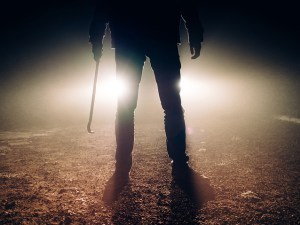 Sure, readers have probably never been terrorized by a serial killer, vampire or demon in their own lives, but they know what it is to feel terror. Likewise, a roguish yet handsome highwayman has likely not pursued them in a roar of love and lust, yet they know what love and lust feel like.
Sure, readers have probably never been terrorized by a serial killer, vampire or demon in their own lives, but they know what it is to feel terror. Likewise, a roguish yet handsome highwayman has likely not pursued them in a roar of love and lust, yet they know what love and lust feel like.
As people, we have an unending spectrum of emotional experiences. We know sorrow and confusion, humiliation, fear and pride. We have experienced satisfaction, confidence, worry and dread. As writers, it is up to us to convey these feelings through our characters so that our description awakens deep and meaningful memories within readers.
Showing what a character is feeling can be difficult for writers. Here are 3 tips to help ensure readers share the character’s emotional ride:
1) Prime your readers
 Spend a bit of time early on showing what has led to your character’s emotional sensitivity. Let’s say themes of betrayal are key to your book & the character’s ‘dark moment.’ If you alluded to a past betrayal by the main character’s mother in a scene before this point, then your heroine seeing an old toy from her childhood will become an instant trigger for those past feelings.
Spend a bit of time early on showing what has led to your character’s emotional sensitivity. Let’s say themes of betrayal are key to your book & the character’s ‘dark moment.’ If you alluded to a past betrayal by the main character’s mother in a scene before this point, then your heroine seeing an old toy from her childhood will become an instant trigger for those past feelings.
2) Focus on what causes the emotional reaction
Sometimes the best way to bring about an emotional moment is to describe what is causing the feeling. For example, let’s say Alexa likes Ethan, the boy next door. She is trying to work up the courage to show him she wants to be more than friends when she spots her rival Jessica at his locker. If you describe how Jessica touches his arm when she laughs, steps closer as he speaks, fiddles with her low necklace to draw his attention to her cleavage, etc. then your reader will feel that jealousy build even without showing Alexa’s thoughts or physical cues.
3) Think about how you might feel
If you are drawing a blank on how to show what your character is feeling, think about how the emotion you’re trying to describe makes you feel. Dig into your past to a time you felt embarrassed, or angry, frustrated, excited…whichever emotion is the one your character is currently facing. What sort of thoughts went through your head? What did your body do? Did you openly show how you felt through gestures and body language, or did you try to hide it? Then, decide if some of your experience can be adapted to your character. Emotion is strongest when it comes from a place of truth.
For more tips on emotional showing, have a peek through your Emotion Thesaurus, or browse the tutorials and expanded Emotion Thesaurus (15 new entries) at One Stop for Writers.
Image 1: Republica @ Pixabay
Image 2: PDPpics @ Pixabay
The post How To Share Your Protagonist’s Deepest Feelings With Readers appeared first on WRITERS HELPING WRITERS™.
April 23, 2016
Emotional Wounds Entry: the Death of a Child on One’s Watch
When you’re writing a character, it’s important to know why she is the way she is. Knowing her backstory is important to achieving this end, and one of the most impactful pieces of a character’s backstory is her emotional wound. This negative experience from the past is so intense that a character will go to great lengths to avoid experiencing that kind of pain and negative emotion again. As a result, certain behaviors, beliefs, and character traits will emerge.
Characters, like real people, are unique, and will respond to wounding events differently. The vast array of possible emotional wounds combined with each character’s personality gives you many options in terms of how your character will turn out. With the right amount of exploration, you should be able to come up with a character whose past appropriately affects her present, resulting in a realistic character that will ring true with readers. Understanding what wounds a protagonist bears will also help you plot out her arc, creating a compelling journey of change that will satisfy readers.
NOTE: We realize that sometimes a wound we profile may have personal meaning, stirring up the past for some of our readers. It is not our intent to create emotional turmoil. Please know that we research each wounding topic carefully to treat it with the utmost respect.

Courtesy: Alan Levine @ CreativeCommons
Examples: Being in charge of one’s child when he/she dies due to
drowning
choking on food
a food allergy
ingesting poison or pills
being strangled by a cord or paper bag
falling from a height (down a flight of stairs, out a window, from a jungle gym or tree)
shooting himself with a parent’s gun
being backed over with a car
being left in a hot car
being killed in a fire due to playing with matches
running into traffic and being hit by a car
Basic Needs Often Compromised By This Wound: love and belonging, esteem and recognition, self-actualization
False Beliefs That May Be Embraced As a Result of This Wound:
I can’t be responsible for the life of another.
I’m untrustworthy/irresponsible.
I’m a terrible parent.
This wouldn’t have happened on someone else’s watch.
I don’t deserve forgiveness.
Loving another only leads to heartache.
Positive Attributes That May Result: alert, cautious, meticulous, observant, private, proactive, protective, responsible
Negative Traits That May Result: addictive, callous, cynical, evasive, fussy, humorless, inhibited, insecure, irrational, irresponsible, morbid, needy, nervous, obsessive, possessive, resentful, self-destructive, temperamental, uncommunicative, withdrawn
Resulting Fears:
If I’m left in charge of a child again, the same thing will happen.
I can’t be responsible for anyone.
My spouse will never forgive me.
I will never recover from this.
I’ll always be known as the parent who let their child die.
If I love another child, he/she will be taken from me.
Possible Habits That May Emerge:
Withdrawing one’s love from other children
Withdrawing from one’s spouse
Avoiding being left in charge of one’s other children
Avoiding children and places where children gather
Becoming obsessive or compulsive in an effort to not miss anything again
Being overprotective and overly strict with one’s remaining children
Withdrawing from others out of shame
Not opening up to others
Becoming a hermit
Being reluctant to make new friends
Becoming depressed
Self-medicating
Becoming obsessed with the deceased child; being unable to let go
Self-loathing; engaging in self-destructive behaviors
Becoming defensive; blaming others out of a need to prove one isn’t to blame
Moving to a new house, city, or state in an effort to distance oneself from what happened
TIP: If you need help understanding the impact of these factors, please read our introductory post on the Emotional Wound Thesaurus. For our current list of Emotional Wound Entries, go here.
For other Descriptive Thesaurus Collections, go here.
The post Emotional Wounds Entry: the Death of a Child on One’s Watch appeared first on WRITERS HELPING WRITERS™.
April 19, 2016
Friends as Enemies
As many of you know, Angela and I have been whipping The Setting Thesaurus manuscripts into shape so they can be released into the world in just a few months. (*squeal*) Each entry has a lot of good information, but one of the fields kept drawing my attention:
(PSSST! The books aren’t out yet, but I pulled this tidbit from One Stop For Writers, where all the settings can currently be found. Subscribers can access the entries in their entirety while registered users can see a sampling.)
As a writer, I’m constantly looking for sources of conflict for my stories. This is one of the reasons we included this field, because people are our greatest resource when it comes to conflict. So looking at the kinds of people typically found in a given setting can give you an idea for who might cause trouble for your hero.
But as I was brainstorming for this field, one thought kept coming back to me: But what about the friends?

Courtesy: Antoine K @ CreativeCommons
I’m not talking about the friends that your character thinks are friends but end up stabbing her in the back. I’m talking about real friends who cause real trouble, often unintentionally.
As we know, friends, family, and allies can cause conflict, too. And because of their close connection with the main character, trouble from a friend inherently equates to elevated emotions for the hero. Plus, friends are so accessible; you won’t typically have to orchestrate a meeting in order to make the sparks fly because the friends are already there.
So it makes sense to use those closest to the hero to add conflict. But what kind of trouble can a true friend cause? Here are a few possibilities:
Opposing Goals: Throughout your story, your hero should have something he’s trying to achieve. But at the scene level, he should also have goals—smaller micro-goals that move him toward getting what he wants overall. Conflict comes in the form of people, forces, things, etc. that block the character from getting what he wants. Oftentimes this comes in the form of the antagonist, who is actively working against the character. But what if the character with the opposing goal is his friend? Fireworks, that’s what happens, between the hero and the person he thought was on his side.
Shared Goals: Another form of conflict comes when two characters want the same thing. Again, the typical scenario is the character and the antagonist or a rival going after the same objective—getting the boy/girl, winning the game/court case/contest, getting a spot on the team, etc. But it gets a lot more complicated when the person competing with the character is a trusted ally.
Clashing Traits: Every person is different, and though our friends are often somewhat similar to us, they’re not carbon copies. The same is true with characters and their cronies. Each member of the cast has traits, both positive and negative, that don’t go well together. Imagine a responsible and rule-following hero combined with a reckless friend. A controlling hero and a rebellious friend. Hard-working vs. lazy. Sensitive vs. tactless. Friends with opposing traits are going to get on each others nerves. Remember this in the planning stages of your story and you’ll end up with built-in conflict that’s easy to access.
Moral Arguments: Though friends aren’t going to agree on everything, every person has certain moral lines they’re not willing to cross. And though they know that other people don’t necessarily share their values, they don’t like them to cross those lines, either. While friends are willing to compromise on certain things, it’s much harder for them to give ground when it comes to questions of right and wrong. Knowing what values your character holds dear can help you use those values against him when conflict is necessary.
Envy: No matter how gifted, successful, good-looking, or popular a person is, there’s always someone who’s MORE gifted, BETTER looking, etc. Envy is an ugly emotion, beginning with negative thoughts that often turn to negative behaviors. When envy manifests between friends, it becomes much more complex, with higher stakes.
Insecurities: Every character has insecurities that make them doubt themselves and skew their view of the world and others. These insecurities can lead to poor decisions that impact the people around them. For instance, someone who’s insecure about his popularity may crack jokes at a friend’s expense if it will get him a few laughs. A girl who is insecure about her looks might latch on to anyone who pays her attention—even if that person is her best friend’s ex. If you’re looking for conflict between friends, figure out what insecurities exist and see what you can do to manipulate them.
Weak Moments: Let’s face it: no one is perfect. No matter how strong a friendship is, every person has selfish moments where they just want to do what they want to do no matter how it might affect others. What might that look like? Canceling plans with a friend when a better opportunity comes along. Not standing up for someone. Kissing a friend’s sister. Poor decisions are easy to justify, and our characters might convince themselves that these choices are no big deal. But weak moments often lead to huge fallout, making for great conflict.
Growing apart: It’s an unfortunate truth of friendship, but sometimes people just grow apart. Interests change, new groups are joined, people move on from a relationship that is holding them back in other areas or is unhealthy in some way. This is natural, but it doesn’t happen all at once. Before people have fully moved on, there’s often a long process full of awkward moments and uncomfortable emotions like confusion, self-doubt, anger, hurt, and bitterness. This leads to lots of potential conflict as friends try to figure out what’s happening and come to grips with the new dynamic.
The list of conflict between friends could probably go on and on, but these are a few of the ways that true friends can cause problems for your main character. Do you have any to add? Please share them in the comments!
The post Friends as Enemies appeared first on WRITERS HELPING WRITERS™.
April 11, 2016
The Emotion Roller Coaster: Why Characters Resist Change
I’m reading this fascinating book right now about the human brain (yes, really!) that details how our gray matter works, and how we can evolve ourselves through concentrated intention and awareness. One of the terrific nuggets is the belief that every emotion, good or bad, sends a flood of chemicals through the body, and that repeated “doses” of this cocktail turns our brain into a bit of an addict, making it hard to break an emotional habit should we wish to.
 What does this mean? Well, if you are trying to claw past feelings of low self-worth brought on by past trauma, or you’re determined to think positively and fight the cloud of pessimism that always seems to envelope you, your brain may actually work against you. Why? Because you’re denying it the rush of chemicals it’s gotten used to. So, craving a hit, it hammers your mind with defeatist thoughts (you’ll never be good enough, so why try? or, someone else would have handled that better) which encourage you to “give in,” and feel the very thing (emotion/chemical mix) you’re trying to avoid.
What does this mean? Well, if you are trying to claw past feelings of low self-worth brought on by past trauma, or you’re determined to think positively and fight the cloud of pessimism that always seems to envelope you, your brain may actually work against you. Why? Because you’re denying it the rush of chemicals it’s gotten used to. So, craving a hit, it hammers your mind with defeatist thoughts (you’ll never be good enough, so why try? or, someone else would have handled that better) which encourage you to “give in,” and feel the very thing (emotion/chemical mix) you’re trying to avoid.
 Anyway, this is an oversimplification so I recommend reading the book, but it got me thinking about WHY change is so hard for us, and therefore our characters as well.
Anyway, this is an oversimplification so I recommend reading the book, but it got me thinking about WHY change is so hard for us, and therefore our characters as well.
First off, change is HUGE.
It triggers an emotional response because we need time to process it. In essence, we’re giving up one idea for something else. It’s the death of one thing, and the birth of another.
Because of this, characters facing change may experience the 5 Stages of Grief:
SHOCK & DENIAL:
What? I don’t need to change! Everything’s fine, F-I-N-E.
ANGER:
How dare you tell me I must change! I’ll cut you, I swear.
DEPRESSION:
My life is over–nothing will ever be the same. I am losing who I am. #cuewallowing
BARGAINING:
But…what if I just do X? That’s good enough, right? Come on, help a bro out.
ACCEPTANCE:
Well, this is the new normal I guess. Better get on with it.
And, in some circumstances, characters will skip the queue and go right to Acceptance, because the change represents something they have longed for or really need. They may feel RELIEF, GRATITUDE or even EXCITEMENT.
But much more often, characters resist, creating a beautiful tug-of-war between Inner Motivation and Inner Conflict, which adds story tension.
Here are some of the common reasons people (and therefore characters) fight change:
Comfort Zone Issues (FEAR)
One of the biggest reasons to resist is our need to maintain the status quo. The comfort zone is known and safe. We like it here. Sure, it’s not perfect, and sometimes it may feel like we’re in a rut, but we’re used to it and know how things works. But…out there in the badlands? Who knows what kind of clown-crazy goes on. Maybe it’s better, but maybe it’s worse. We just don’t know, and neither do our characters, and flight-or-fight instincts can push us to pick what we know over what we don’t.
Threats To The Status Quo (RESENTMENT)
Remember that epic party you threw when your parents went out of town, but then the cops came and busted it up? Okay, well maybe you don’t, but either way, no one likes it when someone or something messes up a good thing. If there’s a threat to your character’s dominance, authority, or control, it’s rarely well received. Your character may not only oppose the change, they might fight back, hard.
 It Upsets Personal Autonomy (ANGER)
It Upsets Personal Autonomy (ANGER)Many of us want to carve our own path, so when someone shows up to tell us we can’t, it causes serious friction. Characters will also naturally resist change if it means giving up freedom or control, unless they are self-aware enough to see it makes sense for the greater good.
It Requires A Leap Of Faith (UNCERTAINTY)
When it comes to our well-being, we want to glimpse the end zone or see data points before making big decisions that affect not only us but possibly others we care about as well. And, like us, if a proposed change has too many unknowns, or could have unmapped side effects, most characters will adopt a “wait and see” mentality and delay decisions, hoping more information will be forthcoming and allow them to make a more informed choice.
A Lack of Confidence (SKEPTICISM)
Sometimes a change isn’t bad, but the plan in place or the person manning the helm is. If a character doesn’t have faith in the leader or feels the plan is somehow fundamentally flawed, they will resist change…especially if they have a better idea on how to move forward.
Painful Past Lessons (RELUCTANCE & DREAD)
Sometimes change is a merry-go-round, and characters who have ridden this particular ride before and it didn’t end well are reluctant to saddle up again. The deeper the pain, the more resistance the character will display. Wounds are powerful and can easily override logic, leaving characters blind to an important truth even if it is staring them in the face.
Change isn’t easy…and often comes at a price
If you’d like help planning your character’s emotional roller coaster as they navigate a change arc, you may find our Story Map tool at One Stop For Writers really helpful. And while you’re there, check out the Emotion Thesaurus and the 15 new entries we’ve added to it.
How does your hero or heroine resist change? Let me know in the comments!
Image 1: Geralt @ Pixabay
Image 2: Wenphotos @ pixabay
Image 3: PublicDomainImages @ pixabay
The post The Emotion Roller Coaster: Why Characters Resist Change appeared first on WRITERS HELPING WRITERS™.
April 9, 2016
Emotional Wound: Financial Ruin Due To A Spouse’s Irresponsibility
When you’re writing a character, it’s important to know why she is the way she is. Knowing her backstory is important to achieving this end, and one of the most impactful pieces of a character’s backstory is her emotional wound. This negative experience from the past is so intense that a character will go to great lengths to avoid experiencing that kind of pain and negative emotion again. As a result, certain behaviors, beliefs, and character traits will emerge.
 Characters, like real people, are unique, and will respond to wounding events differently. The vast array of possible emotional wounds combined with each character’s personality gives you many options in terms of how your character will turn out. With the right amount of exploration, you should be able to come up with a character whose past appropriately affects her present, resulting in a realistic character that will ring true with readers. Understanding what wounds a protagonist bears will also help you plot out her arc, creating a compelling journey of change that will satisfy readers.
Characters, like real people, are unique, and will respond to wounding events differently. The vast array of possible emotional wounds combined with each character’s personality gives you many options in terms of how your character will turn out. With the right amount of exploration, you should be able to come up with a character whose past appropriately affects her present, resulting in a realistic character that will ring true with readers. Understanding what wounds a protagonist bears will also help you plot out her arc, creating a compelling journey of change that will satisfy readers.
NOTE: We realize that sometimes a wound we profile may have personal meaning, stirring up the past for some of our readers. It is not our intent to create emotional turmoil. Please know that we research each wounding topic carefully to treat it with the utmost respect.
FINANCIAL RUIN DUE TO A SPOUSE’S IRRESPONSIBILITY
Examples:
Secretly overextending credit and being unable to hide the lie any longer
Gambling debts
Investments that have soured which one’s spouse has kept quiet about
Draining one’s accounts to pay for a habit (drinking, drugs, prostitutes, etc.)
A spouse who loses their job and uses savings to cover it up
A spouse who was cat-fished during an extra-marital affair
Falling prey to scams and not wising up in time
A spouse who helps a friend or relative and is left holding the bag
A spouse who is a hoarder/collector
A spouse who is addicted to online shopping
A spouse who maxes credit cards in secret
Basic Needs Often Compromised By This Wound: physiological needs, safety and security, love and belonging, esteem and recognition, self-actualization
False Beliefs That May Be Embraced As a Result of This Wound:
I can’t trust anyone to handle money but myself
I can’t trust my own instincts
I need to control all aspects of my life
I need to use my head, not my heart
The only way my future is safe is if I am in control
Positive Attributes That May Result: analytical, cautious, decisive, disciplined, efficient, industrious, intelligent, meticulous, organized, persistent, proactive, protective, resourceful, sensible, thrifty, wise
Negative Traits That May Result: compulsive, controlling, greedy, humorless, impatient, inflexible, judgemental, nagging, obsessive, possessive, resentful, stingy, workaholic, worrywart
Resulting Fears:
Fear of trusting in the wrong person
Fear of poverty
Fear of the future
Fear of going in debt
Fear of making a bad decision with lasting effects
Fear of illness or disaster
Fear of risks
Possible Habits That May Emerge:
Obsessive bank account watching
Demanding to know how money is being spent within the family (wanting to see receipts, etc.)
Restricting access to one’s accounts and investments
Refusing to use credit cards
Coupon-clipping
Avoiding social situations where one will be expected to spend money
Only engaging in free activities
Feeling guilty when one spends money on oneself
Buying used rather than new
Minimizing the importance of holidays to avoid having to buy gifts (Birthdays, Christmas, etc.)
Not going out with friends to avoid spending money
Reusing and repurposing
Going without
Becoming anti-risk (to one’s health, with one’s things, etc.)
Taking advantage of any money-making opportunity
Taking on extra jobs and sacrificing down time to do so
TIP: If you need help understanding the impact of these factors, please read our introductory post on the Emotional Wound Thesaurus. For our current list of Emotional Wound Entries, go here.
For other Descriptive Thesaurus Collections, go here.
Image: StevePB @ Pixabay
The post Emotional Wound: Financial Ruin Due To A Spouse’s Irresponsibility appeared first on WRITERS HELPING WRITERS™.
April 5, 2016
Critiques 4 U

Courtesy: Pixabay
Hello, everyone! Is spring in the air where you are? I hope so. It’s warming up nicely here, and now that Angela and I have polished off two very important deadlines, I’ve got time to get back to first pages. I think I’ll be critiquing this month’s winners on the front porch :).
If you’re working on a first page and would like some objective feedback, please leave a comment that includes:
1) your email address. Some of you have expressed concern about making your email address public; if you’re sure that the email address associated with your WordPress account is correct, you don’t have to include it here. But if you do win and I’m unable to contact you through that email address, I’ll have to choose an alternate winner.
2) your story’s genre (no erotica, please)
ONLY ENTRIES THAT FOLLOW THESE INSTRUCTIONS WILL BE CONSIDERED
Three commenters’ names will be randomly drawn and posted tomorrow. If you win, you can email me your first page and I’ll offer my feedback. Best of luck!
The post Critiques 4 U appeared first on WRITERS HELPING WRITERS™.
Writers Helping Writers
- Angela Ackerman's profile
- 1014 followers






